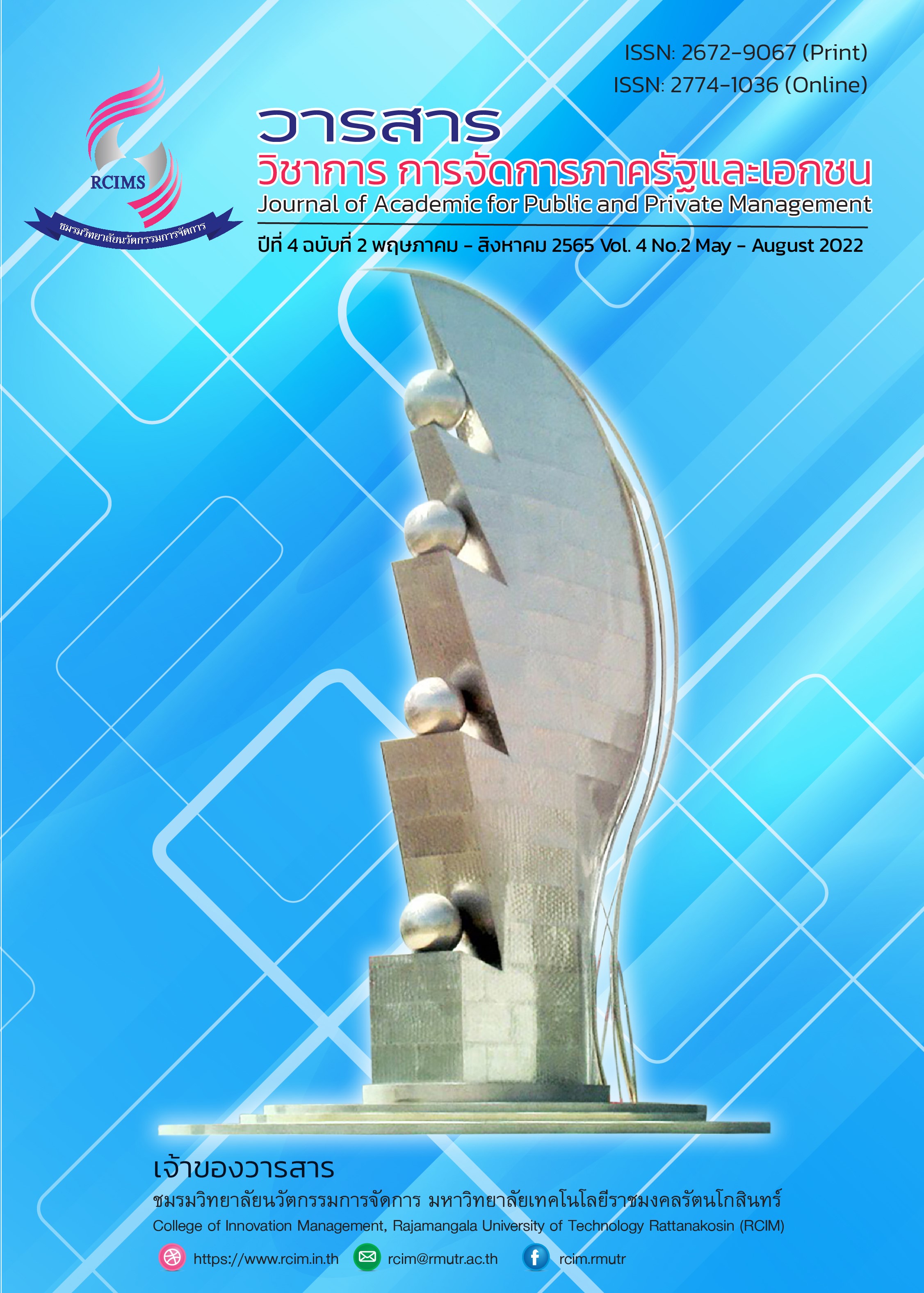นวัตกรรมภาครัฐในการแก้ไขปัญหาน้ำเค็มรุกล้ำทะเลสาบและพื้นที่การเกษตรซ้ำซากในลุ่มน้ำทะเลสาบสงขลาของไทย
Main Article Content
บทคัดย่อ
สถานการณ์น้ำเค็มบุกรุกทะเลสาบและพื้นที่การเกษตรทวีความรุนแรงและส่งผลกระทบต่อการดำรงชีวิตของประชากรทั่วโลก การศึกษานี้มีวัตถุประสงค์ศึกษาปัจจัยนำเข้า กระบวนการและผลผลิตนวัตกรรมภาครัฐในการแก้ไขปัญหาน้ำเค็มรุกล้ำทะเลสาบและพื้นที่การเกษตรซ้ำซากในลุ่มน้ำทะเลสาบสงขลา การศึกษาใช้การวิจัยเชิงคุณภาพภายใต้การประยุกต์การวิจัยเชิงปฏิบัติการแบบมีส่วนร่วม
โดยสัมภาษณ์เชิงลึกและการประชุมกลุ่มย่อย รวมถึงเก็บข้อมูลด้วยแบบสัมภาษณ์แบบกึ่งโครงสร้าง การศึกษา พบว่า ปัจจัยนำเข้านวัตกรรมภาครัฐในการแก้ไขปัญหาการบุกรุกของน้ำทะเล ได้แก่ ภาวะผู้นำ ซึ่งประกอบด้วย ผู้นำภาครัฐ ผู้นำชุมชนและผู้นำส่วนกลาง ในขณะที่กระบวนการนวัตกรรมภาครัฐในการแก้ไขปัญหาการบุกรุกของน้ำทะเล ประกอบด้วย การออกแบบองค์กรภาครัฐ การสร้างกลไกการแก้ไขปัญหาอย่างครบวงจร การเปิดช่องทางการแก้ไขปัญหาอย่างเป็นวิทยาศาสตร์ และการจัดสรรงบประมาณเพิ่มศักยภาพองค์กรปกครองส่วนท้องถิ่น ส่วนผลผลิตนวัตกรรมภาครัฐในการแก้ไขปัญหาการบุกรุกของน้ำทะเล ก่อให้เกิดการเพิ่มประสิทธิภาพโครงการและลดการแก้ปัญหาน้ำทะเลบุกรุกด้วยโครงการระยะสั้น
Article Details

อนุญาตภายใต้เงื่อนไข Creative Commons Attribution-NonCommercial-NoDerivatives 4.0 International License.
เอกสารอ้างอิง
มติชนออนไลน์. (2563). ต้าน ‘แล้ง’ ไปด้วยกัน น้ำจืดขาด น้ำเค็มรุก อย่าทำแค่ ‘ตั้งรับ’ ปลุกนวัตกรรมสู้วิกฤต. สืบค้นเมื่อ 20 ธันวาคม 2563, จาก https://www.matichon.co.th/prachachuen/prachachu
en-scoop/news_1989697.
สำนักกรรมาธิการ 1 สำนักงานเลขาธิการวุฒิสภา. (2559). วิกฤตทะเลสาบสงขลาสู่การพัฒนาที่ยั่งยืน. กรุงเทพฯ: สำนักงานเลขาธิการวุฒิสภา.
สำนักงานสิ่งแวดล้อมภาคที่ 16 สำนักงานปลัดกระทรวงทรัพยากรธรรมชาติและสิ่งแวดล้อม. (2550). โครงการพัฒนาระบบข้อมูลสถานการณ์คุณภาพน้ำ: หนึ่งท้องถิ่น หนึ่งจุดติดตามตรวจสอบคุณภาพน้ำ. สงขลา: สำนักงานสิ่งแวดล้อมภาคที่ 16.
Daglio, M. et al., (2014). Building Organisational Capacity for Public Sector Innovation. Paper prepared for the OECD Conference in Innovating the Public Sector: from Ideas to Impact. Paris, 12-13 November 2014.
Davis, C. R. (2018). Modeling the Co-Production of Public Sector Innovation: Strategic Dimensions of Organizational Innovation within the Public Maritime Ports of the Pacific Northwest (Doctoral Dissertation). Portland State University.
European Commission, Directorate-General for Research and Innovation. (2013). Powering European Public Sector Innovation: Towards A New Architecture - Report of the Expert Group on Public Sector Innovation. Luxembourg: Publications Office.
Haley, B. (2016). Getting the Institutions Right: Designing the Public Sector to Promote Clean Innovation. Canadian Public Policy, 42(S1), S54-S66.
Hannon, M. et al., (2017). Examining the Effectiveness of Support for UK Wave Energy Innovation since 2000: Lost at Sea or a New Wave of Innovation?. Prometheus, 35(2), 145–158.
Hennala, L. and Melkas, H. (2016). Understanding Users’ Collective Voice in Public Service Innovation. Knowledge and Process Management, 23(1), 62–72.
Kattel, R. (2015). What Would Max Weber Say About Public-Sector Innovation?. NISPAcee Journal of Public Administration & Policy, 8(1), 9-19.
Kurteshi, R. (2018). Discovering and Reviewing the Internal and External Drivers of Innovation and Localized Cultivation of an Innovation Culture in the Public Sector: The Case of Kosovo. European Journal of Economic Studies, 7(2), 77-88.
Li, Y. (2021). A Framework in Analysing the Strategies for Governing Innovation Networks for Public Innovation. Policy Studies, 42(2), 193-209.
McGann, M. et al., (2018). The Rise of Public Sector Innovation Labs: Experiments in Design Thinking for Policy. Policy Sci, 51(3), 249–267.
Moussa, M. et al., (2018). A Conceptual Framework of the Factors Influencing Innovation in Public Sector Organizations. Journal of Developing Areas, 52(3), 231-240.
Parker, R. J. (1993). The Use of a Participatory Action Research (PAR) Process to Identify and Prioritize Issues with in the Midwest Region National Park System. (Doctoral Dissertation). University of Minnesota.
Plaza. A. L. (2012). Use of a Modified Delphi Process for Establishing Occupational Exposure Limits in Support of Health Surveillance for Space Travelers. (Doctoral Dissertation). University of Texas.
Reiljan, J. and Paltser, I. (2015). The Role of Innovation Policy in the National Innovation System: The Case of Estonia. Trames, 19(3), 249-272.
Sangiorgi, D. (2015). Designing for Public Sector Innovation in the UK: Design Strategies for Paradigm Shifts. Foresight, 17(4), 332-348.
Shang, et al. (2018). Innovation or Imitation - a Comparison of Performance Evaluation Models in China. Transylvanian Review of Administrative Sciences, 14, 138-154.
Tiganasu, R. et al., (2019). Performance and Innovation in the Public Sector of the European Union Countries. An Analysis Based on the Dynamics of Perceptions, 2009-2016. Transylvanian Review of Administrative Sciences, 15(SI), 94-123.
Vollman, A. R. et al., (2004). Canadian Community as Partner. Philadelphia, PA: Lippincott Williams & Wilkins.
Vrabie, A. and Lanole-Călin, R. (2020). A Comparative Analysis of Municipal Public Innovation: Evidence from Romania and United States. Journal of Open Innovation: Technology, Market, and Complexity. 6(4), 1-21.
Vries, H. de. et al., (2016). Innovation in the Public Sector: A Systematic Review and Future Research Agenda. Public Administration, 94(1), 146–166.


